
Ending The Essential Air Service Would Save $200 Million Annually
December 25, 2023
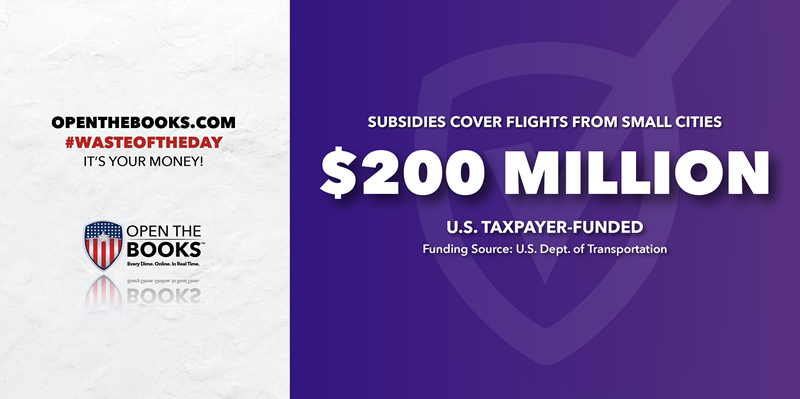
The Essential Air Service, a way to provide air service in smaller communities, costs the U.S. $200 million every year for the barely-used, highly-subsidized program, according to Citizens Against Government Waste’s annual report “Prime Cuts,” a list of recommendations to reduce the record national debt.
The service was created in 1978 as a temporary measure to provide flights to smaller communities after airline deregulation. The concern was that small cities would lose air service, as airlines would choose larger, more lucrative routes.
Intended to sunset after a decade, the program has been operating for 45 years, with the U.S. Department of Transportation providing subsidies to 175 rural communities in 32 states and Puerto Rico.
Most cities are subsidized at more than $100 per passenger, supporting largely empty flights that otherwise would never leave the ground.
The cities selected for the service haven’t changed since its inception, making small towns with approximately 10,000 people get subsidies.
“Tiny Ogdensburg, NY with 10,000 people and Massena, NY with 12,000 people get subsidies,” an airline industry executive wrote in Forbes. “Yet nearby Watertown, NY, with over 25,000 people, gets no subsidies today. People in Watertown must drive the just over one-hour trip to Syracuse, NY for their flights while the much smaller subsidized cities can board at their local airport on the taxpayer’s dime. Populations have changed in the last 40 years, but the EAS city designations haven’t kept pace."
The program can spend thousands per passenger in rural areas and provide service to less than 30 passengers daily.
An airport in Johnstown, Pennsylvania gets an EAS subsidy, “tirelessly defended by the late Rep. John Murtha (D-Pa.), from which just 18 flights leave each week. Johnstown is only two hours east of Pittsburgh International Airport by car,” Citizens Against Government Waste reported.
A 2015 study from West Virginia University found “strong evidence that subsidies are higher in districts having congressional representation on the House Transportation Committee.”
Other investigations have found “one flight between Baltimore and Hagerstown, Maryland – just about 75 miles apart – was so sparse the captain allowed the only other passenger who wasn’t our producer to sit in the co-pilot’s seat,” and cited two other flights on the same route with just one passenger each.
The investigative team found that, “A 19-seat plane from Cleveland to Dubois, Pennsylvania, about 180 miles east, had just one passenger as well.”
While the Federal Aviation Administration funding bill that passed in February 2012 limited EAS funding to airports that are more than 175 miles from a major hub and that move more than 10 passengers a day, it makes much more sense to eliminate the program entirely.
$70K For Temporary Poem In Reno, Nevada
December 26, 2023
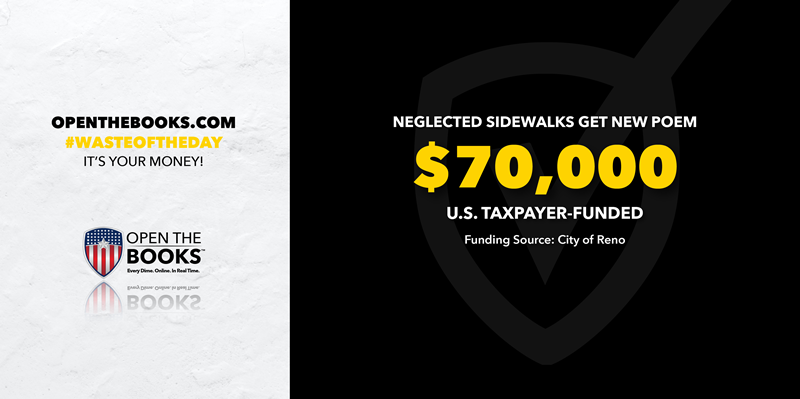
A 4,000-word poem was temporarily printed along one-mile of Reno, Nevada sidewalks, at a cost of $70,000.
The poem “Confluence: Stream Science, Handwriting, and Urban Curbs,” is a project by Todd Gilens, a Bay Area visual artist who first had the idea in 2014.
“The portioned themes of the composition are based on water, land, science and seasonal motifs and are “expressed in rhythmic prose,” which is meant to be read while walking,” This Is Reno reported.
The lettering, added in October, was expected to last several weeks, depending on weather conditions, the local news site reported.
The Nevada Globe poked fun at the installation – paid for by the City of Reno, Washoe County, Nevada Humanities, and the Truckee Meadows Parks Foundation.
“If, God forbid, a pedestrian is distracted by “Confluence,” he might get a closer look at the temporary scrawl if he trips over the cracks in the neglected, uneven sidewalk,” the news outlet wrote. “The City of Reno can’t find the funds or the will to repair a neglected sidewalk, but the bureaucrats can find the funds to temporarily paint it.”
This is also as residents of Reno and the Washoe County School District are facing an additional Storm Water Utility tax proposed by the City Council, averaging an initial $13.49 per month. The tax will have automatic, annual increases based on the Consumer Price Index and there is no cap.
If Reno City Council approves this tax, residents and businesses in Damonte Ranch will have to pay two taxes per month for sewer infrastructure.
But by all means, lets paint a temporary poem on the sidewalks.
As the Nevada Globe put it, “One question we have is why a temporary, mile-long poem (that costs $70,000) is necessary?”
Dog Lovers Oppose L.A. Plan For $58 Million Bike Path
December 27, 2023
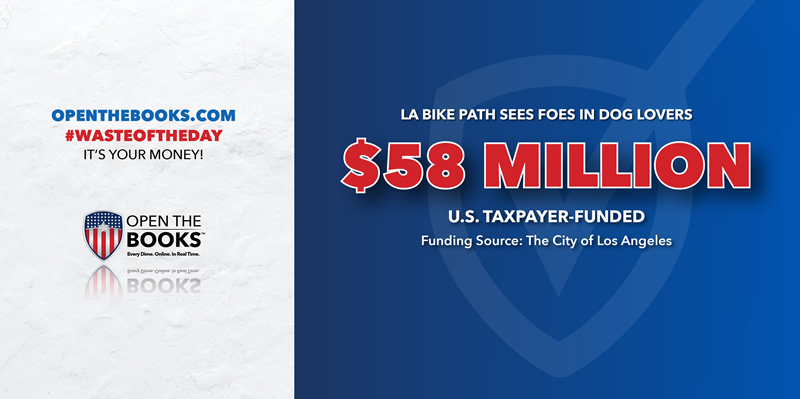
The City of Los Angeles is spending $58.4 million for a three-mile bike lane and greenway project – costing $19 million per mile the Los Angeles Times reported.
Advocates of the L.A. River, and neighborhood councils have criticized the cost and location of the $58.4 million bike lane and greenway project. One environmental group wrote a public letter stating that there is “no supportable justification” for he proposed route and that the most “cost-effective” approach would be to use an existing bike path.
But it’s dog lovers who have the loudest bark, pushing back on its location along the L.A. River in the Sepulveda Basin. It would take out 4,204 square feet of the 6-acre Sepulveda Basin off-leash dog park.
Dog owners have asked for the bike path to be moved to the south side of the river, where there is some empty land and baseball fields. But the city Bureau of Engineering said that is not feasible because it would encroach on the baseball fields and there’s a lack of room on the south side.
To accommodate the dog owners’ concerns, the city is considering installing a 6- to 8-foot-tall fence along the river so that passing bikers won’t agitate the dogs, the Times reported.
This small, pricey chunk of land is part of a larger fight over the future of the Sepulveda Basin, where city officials want to build bicycle paths along the river before the 2028 Summer Olympics.
While this three-mile bike path is costing $19 million per mile, bicyclists and community leaders envision a continuous bike path along the 51-mile river.
Besides the path itself, under crossings, river parks and on-street improvements would be built, the Times reported. The project would see up to 63 trees removed, with the city adding 200 replacement trees.
Army Pamphlet Details Rules of King Of The Hill
December 28, 2023
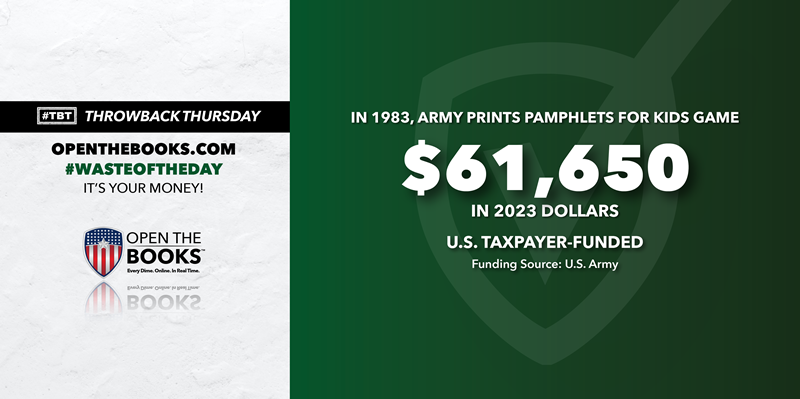
Throwback Thursday!
In 1983, the U.S. Army spent $20,000 — $61,650 in 2023 dollars — to prepare 30,000 fancy, multi-colored pamphlets explaining how to play the children’s’ playground game, King of the Hill.
For this wasteful spending, Sen. William Proxmire, a Democrat from Wisconsin, gave the Army a Golden Fleece Award in 1983. He gave awards to wasteful and nonsensical spending, eventually handing out 168 Golden Fleece Awards between 1975 and 1988.
“The Army has made a mountain out of a molehill but the poor taxpayer have taken the financial tumble,” Proxmire said then.
The pamphlet contained four pages of detailed rules, and a multi-colored diagram of an earthen mound to be used when playing the game. The Army said the purpose of the pamphlet was to “incorporate leadership, strategy planning, and decision-making skills into the physical fitness training program.”
Proxmire called that “nonsense … as the Russian army practices blitzkrieg tactics, massed infrantry attacks, chemical warfare and subversion. Our playing King of the Hill will not keep Defense Minister Ustinov awake nights.”
He added, “King of the Hill has little resemblance to the modern battlefield, which is fluid, makes use of high technology weapons, including remote targeting and attack, and is ot bound by detailed rules,” Proxmire said. “Whatever lessons about strategy which can be learned from King of the Hill will be useless on the battlefield.”
He also noted that children has been learning the rules of their playground game for years without any pamphlet.
“Drill instructors are notably proficient at keeping the troops fit,” he said. “If these instructors want to play King of the Hill to improve fitness, they do not need a Defense Department pamphlet filled with silly rules.”
U.S. DOT Spends $3 Billion On Private High-Speed Rail
December 29, 2023
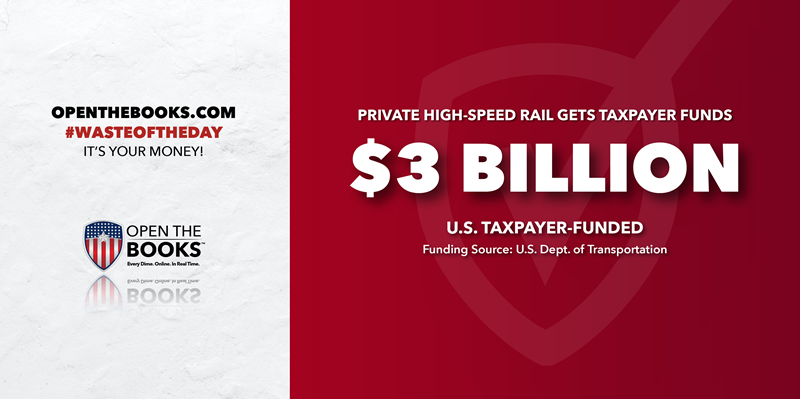
Commuters may want high-speed rail but at what price? Apparently $3 billion. That’s what the U.S. Department of Transportation committed this month for Brightline West, a private intercity passenger railroad, to help build a $12 billion high-speed railway between Las Vegas and Southern California, the Washington Post reported.
Another $3 billion will go to California High-Speed Rail Authority to continue construction of a 500-mile train connecting Los Angeles and San Francisco.
The $3 billion for Brightline is “an almost unheard of infusion of federal money for a private project,” the Post reported. The trains would travel 218 miles Las Vegas and suburban Los Angeles at 186 mph by 2028.
The other three-quarters of the project’s cost would be covered by capital and tax-free debt known as private activity bonds to finance the rest. Company officials claim they needed the federal funding to begin construction.
Brightline West received a $25 million federal grant in June to pay for the design and construction of two stations in California.
Brightline, which is the only private intercity passenger railroad in the U.S., says it would take travelers along the median of the interstate between Las Vegas and Rancho Cucamonga in 2 hours and 10 minutes. Rail advocates say the train would remove about 3 million vehicles from the road, create 35,000 jobs and increase tourism between Nevada and California.
The rail company - which recently expanding it Florida service to Orlando - still hasn’t said how much they’ll charge customers to travel on their private trains. Its website states: “Ticket pricing will be determined closer to the start of operations but can be expected to be priced on par with the cost of gas and parking, but without the stress and extra time in traffic, fluctuating gas prices, and other things that can add time and money to your trip.”
Brightline is aiming its construction completion and opening to be in time for the 2028 Olympics in Los Angeles.
While that’s nice to have for the Olympic games, why should taxpayers give a private train company $3 billion of their dollars?
The #WasteOfTheDay is presented by the forensic auditors at OpenTheBooks.com.